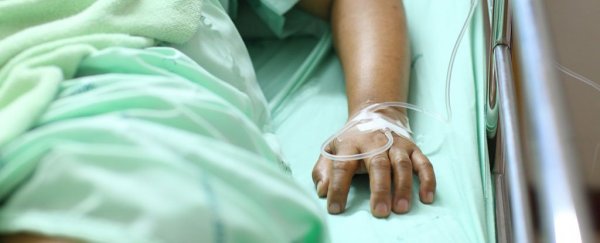Scientists have used electrical stimulation of the brain to give minimally conscious patients the ability to communicate for up to a week, after a repeated series of treatments.
The new technique gives hope to patients and families affected by consciousness disorders, suggesting that there are ways for them to stay connected for days at a time, despite severe damage to the brain.
Minimally conscious states are different from more severe consciousness disorders like persistent vegetative states or locked-in syndrome, because patients can still follow very simple commands, and have purposeful behaviours.
Back in 2014, researchers discovered that running a mild current through the brains of people in a minimally conscious state could help them communicate for up to 2 hours after treatment.
This new study, led by physiotherapist Aurore Thibaut from the University of Liège in Belgium, followed up that earlier research, by applying transcranial direct current stimulations (tDCS) to 16 patients in a double blind, randomised experiment.
Patients were all diagnosed as minimally conscious after some form of brain trauma, oxygen deprivation, or stroke had left them with only low levels of awareness of their surroundings for sustained periods.
Those receiving the treatment had electrodes placed on their scalps and a mild, 2-milliamp current run across their left prefrontal cortex for 20 minutes over five consecutive days.
The control version of the treatments was similar, with the current only being applied for 5 seconds.
As in the previous study, those patients receiving tDCS showed various levels of significant improvement in the scores used to determine their consciousness for up to seven days after the last session, which included consistently responding to commands, recognising the positions of objects, automatic motor responses and following movements with their eyes.
Two patients had improved to the point where they were able to functionally communicate.
"They couldn't speak, but we could ask questions, such as, "Is your name David?" and they answered 'yes' or 'no' by moving a part of their body, like their tongue or their foot," Thibaut told New Scientist.
While four patients responded after the first treatment, reflecting a similar fraction who responded to the single treatment in the 2014 study, other patients took up to four days to show signs of improvement, suggesting that repeated exposure could help treat additional patients.
"The increased effects of tDCS over the sessions could be due to an increase in NMDA receptor excitability, which could improve and strengthen cortical excitability within the stimulated area," the researchers write in their report.
This might not be a cure, but it is a considerable step up from current treatments, including an anti-viral drug typically used to treat Parkinson's disease called amantadine, which has been linked with epileptic seizures,
According to the researchers, TDCS has no reported side effects if used properly.
In fact, in other experiments, this form of electrical stimulation has been shown to improve cognition in healthy research subjects by boosting maths scores, and is even being considered by the military as a way to help personnel concentrate under pressure.
While experts say there are good reasons to remain cautious about its commercialisation, under medical conditions, tDCS appears to be a low risk way for those with disorders of consciousness to awaken to some small degree.
Further studies are needed before anybody can say for certain that it can be considered completely safe for daily use over the long term, or if the treatment's effectiveness might decrease over time.
"We need to see what happens when we use it for perhaps 5 hours a day, or what happens if we apply it daily for three months. We need to be really careful," said Thibaut.
But given the potential, and the fact tDCS devices can be easily used at home, these are some promising signs.
This research was published in Brain Injury.
